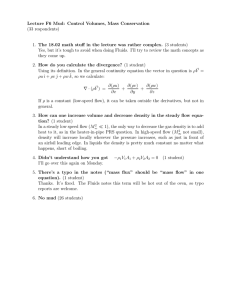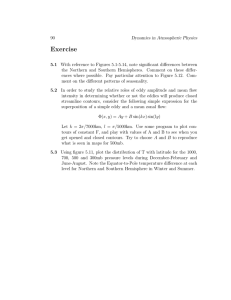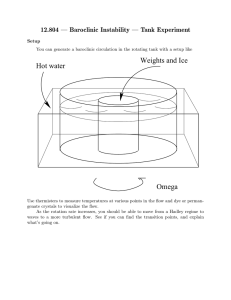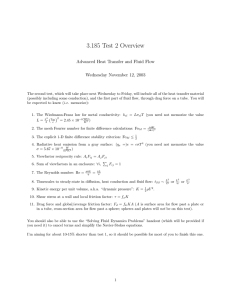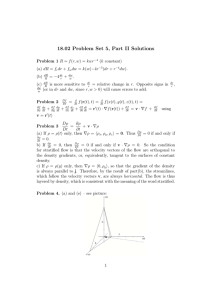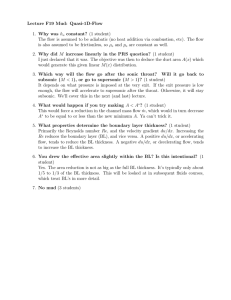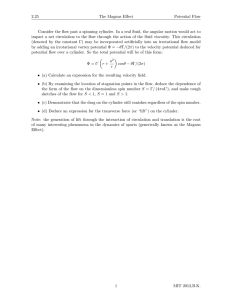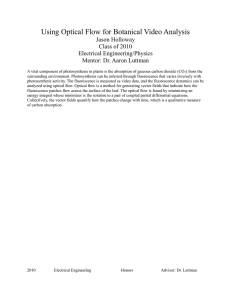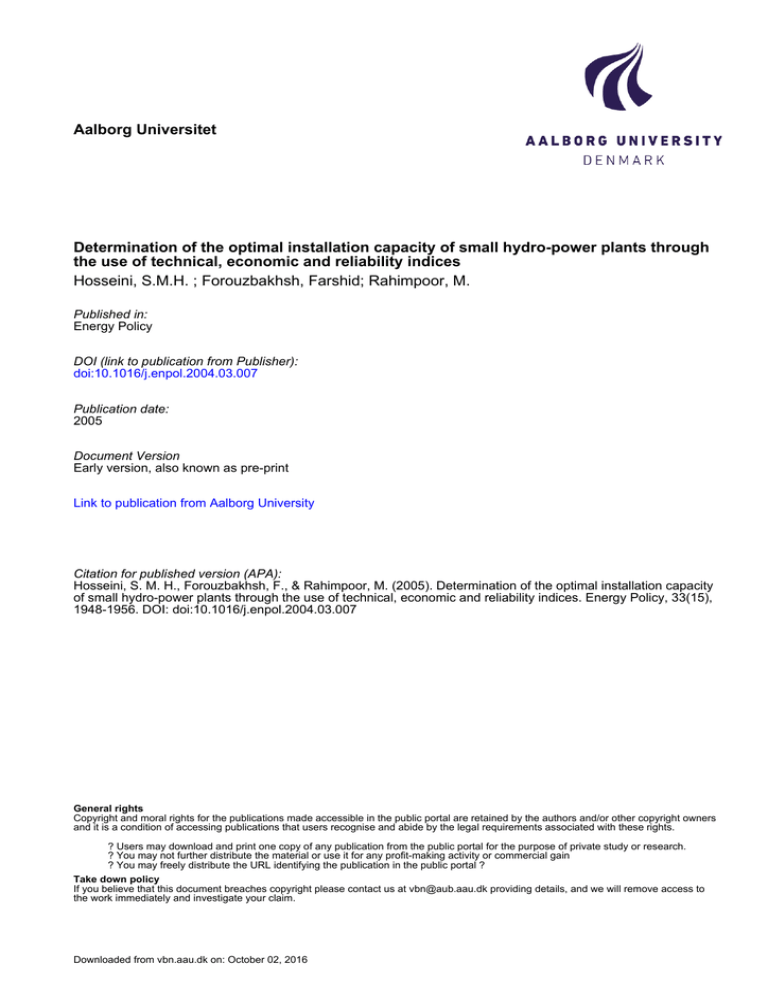
Aalborg Universitet
Determination of the optimal installation capacity of small hydro-power plants through
the use of technical, economic and reliability indices
Hosseini, S.M.H. ; Forouzbakhsh, Farshid; Rahimpoor, M.
Published in:
Energy Policy
DOI (link to publication from Publisher):
doi:10.1016/j.enpol.2004.03.007
Publication date:
2005
Document Version
Early version, also known as pre-print
Link to publication from Aalborg University
Citation for published version (APA):
Hosseini, S. M. H., Forouzbakhsh, F., & Rahimpoor, M. (2005). Determination of the optimal installation capacity
of small hydro-power plants through the use of technical, economic and reliability indices. Energy Policy, 33(15),
1948-1956. DOI: doi:10.1016/j.enpol.2004.03.007
General rights
Copyright and moral rights for the publications made accessible in the public portal are retained by the authors and/or other copyright owners
and it is a condition of accessing publications that users recognise and abide by the legal requirements associated with these rights.
? Users may download and print one copy of any publication from the public portal for the purpose of private study or research.
? You may not further distribute the material or use it for any profit-making activity or commercial gain
? You may freely distribute the URL identifying the publication in the public portal ?
Take down policy
If you believe that this document breaches copyright please contact us at vbn@aub.aau.dk providing details, and we will remove access to
the work immediately and investigate your claim.
Downloaded from vbn.aau.dk on: October 02, 2016
ARTICLE IN PRESS
Energy Policy 33 (2005) 1948–1956
Determination of the optimal installation capacity of small
hydro-power plants through the use of technical,
economic and reliability indices
S.M.H. Hosseinia,*, F. Forouzbakhshb, M. Rahimpoora
a
Electrical Engineering Department, Faculty of Engineering, Islamic Azad University, Tehran South Unit, Mahallati Expway, Tehran, Iran
b
Electrical Engineering Department, Faculty of Engineering, University of Tehran, Campus No.2, North Kargar Ave., Tehran, Iran
Abstract
One of the most important issues in planning Small Hydro-Power Plants (SHPPs) of the ‘‘run-off river’’ type is to determine the
optimal installation capacity of the SHPP and estimate its optimal annual energy value. In this paper, a method to calculate the
annual energy is presented, as is the program developed using Excel software. This program analyzes and estimates the most
important economic indices of an SHPP using the sensitivity analysis method. Another program, developed by Matlab software,
calculates the reliability indices for a number of units of an SHPP with a specified load duration curve using the Monte Carlo
method. Ultimately, comparing the technical, economic and reliability indices will determine the optimal installation capacity of an
SHPP. By applying the above-mentioned algorithm to a sample SHPP named ‘‘Nari’’ (located in the northern part of Iran), the
optimal capacity of 3.75 MW is obtained.
r 2004 Elsevier Ltd. All rights reserved.
Keywords: Installation capacity; Small Hydro-Power Plant (SHPP); Economic analysis; Monte Carlo method
1. Introduction
Small Hydro-Power Plants (SHPPs) have found
special importance due to their relatively low administrative and executive costs, and a short construction
time compared to large power plants. These SHPPs are
in the ‘‘run-off river’’ category because their generated
capacity is based on the deviated water flow of river runoff and consists of a diversion dam, conveyance of water
system, headpond, forebay, penstock, power house, and
tailrace structure of the body of the SHPP as well as
other electrical and mechanical equipment (see Fig. 1).
The deviated flow of a river reaches the forebay
after running in a path to the diverted point, and
then enters into the SHPP structure via penstock pipes.
Daily regulation of the water volume in the headpond is
used to get maximum power from the SHPP during
peak hours. The amount of energy generated during
different daily hours and/or different seasons of the
year are the most important issues worthy of study in
*Corresponding author. Tel.: +98-21-873-8166; fax: +98-21-8737751.
Email-address: smhh110@yahoo.com (S.M.H. Hosseini).
0301-4215/$ - see front matter r 2004 Elsevier Ltd. All rights reserved.
doi:10.1016/j.enpol.2004.03.007
the run-off river SHPP studies. In other words,
calculating the optimal installation capacity (optimal
designed flow) is one of the most important factors in
planning SHPPs.
2. Determination of the optimal installation capacity
To determine the optimal installation capacity of
SHPPs all technical, economic and reliability indices
are considered in a trade-off relation. Using this
approach, the amount of annual energy is determined
by using categorized statistics of the flow duration
curve in different months. Then, after specifying the
income and costs of the plant, the economic indices of
different alternatives are extracted. The reliability
indices are then calculated and ultimately, through
comparison of the technical, economic and reliability
indices, a superior alternative can be selected, determining the optimal installation capacity. This method of
calculating the technical, economic and reliability
indices and the subsequent processes used in the
planning of an SHPP will be further discussed and
described.
ARTICLE IN PRESS
S.M.H. Hosseini et al. / Energy Policy 33 (2005) 1948–1956
1949
Fig. 1. Schematic diagram of a typical small hydro-power plant.
2.1. Method of energy calculation
2.2. Economic calculation method
After determining the downstream water flow and
environmental needs and rights, the energy calculation is
done with respect to the water flow categorized data of
the river. To estimate the generated energy, a range of
flow rate is specified based on a level of adjustment.
Then, based on the daily and/or monthly statistics of the
flow duration curve and the water flow with different
probability percentages (e.g., 20%, 30%, 40%, 50%,
60% and 70%), the monthly optimally generated energy
is calculated. The amount of optimal annual energy
generated is obtained by determining the sum of the
monthly energies. It should be noted that in these
calculations, different sizes of headponds are also
involved. The locations of projects and river water flow
are constrained by the availability of established headponds whose size is an important determining factor.
In addition, with respect to the by-laws of the
Ministry of Energy regarding energy purchases, energy
generation must be divided into three different types:
peak load (4 h a day), normal load (12 h a day) and low
load (8 h a day). The high value of energy is categorized
based on the peak, normal and low loads, respectively,
so the planner can choose different alternatives with the
highest energy generation relative to the load. While
coordinating between energy in peak and base states, the
technical indices such as the plant factor of an SHPP
should be within a reasonable and acceptable limit. With
respect to the role of an SHPP in the load power system
network, the recommended index size with a headpond
should be a figure between 30% and 45%, and without a
headpond, a figure between 45% and 60% (Energy
Ministry of China, 1990).
In this section, the method of evaluation of income
and costs and ultimately, the economic analysis of
SHPPs are described (Hosseini and Forouzbakhsh,
2003). The costs of the project are divided into two
categories: investment and annual costs. Investment
costs include civil costs, electro-mechanical equipment,
power transmission line, and other indirect costs.
Annual costs include the depreciation of equipment,
operating and maintenance, and replacement costs. The
income of the project is based solely on the sale of
electrical energy.
2.2.1. Investment costs
Civil costs consist of the construction and hydrostructural costs of the project, including a dam,
conveyance of water system, the water penstock
structure, a headpond, the forebay, the power house,
the tailrace structure, the access road and any future
unpredicted costs taken from the preliminary designs of
a feasibility study.
Electro mechanical equipment costs include turbines,
generators, governors, gates, control systems, a power
substation, electrical and mechanical auxiliary equipment, etc. With respect to the nature of SHPPs (lower
than 5 MW), the costs are evaluated to be approximately
US$500/kW of power installation. Note that the control
system is assumed to be manual, and the costs of using
remote control would naturally be higher (Hosseini and
Forouzbakhsh, 2003; Aab-niroo Co, Studies Management Office, 2003).
Power transmission line costs include a power transmission line for delivering generated energy from power
ARTICLE IN PRESS
1950
S.M.H. Hosseini et al. / Energy Policy 33 (2005) 1948–1956
plant to power transmission network. The transmission
line cost depends on the location, type of existing system
(overhead line or cable system), and capacity of SHPP
as well as length of transmission lines, which have a very
high affect on project costs.
Indirect costs include Engineering and Design (E&D),
Supervision and Administration (S&A) and inflation
costs during the construction period.
E&D costs: These costs are affected by many
parameters, such as type, size and the location where
the project is being constructed. The E&D costs are
usually expressed as a percentage of construction
costs, including civil and equipment costs, and the
amount of this percent differs from one location to
another. Recently, a case study on these SHPPs has
shown that this figure could range from 5% for small
and medium sized projects, to 8%, for very large
sized projects (Hosseini and Bathaei, 2001; Department of the Army, 1985).
S&A costs: These costs include the purchase of land,
management, inspection and supervision costs, and
other miscellaneous costs in the region. Similar to the
E&D costs, the S&A costs are expressed as a
percentage of the construction costs. A recent case
study on SHPPs has shown that this figure could be
anywhere from 4% to 7% (Hosseini and Bathaei,
2001; Department of the Army, 1985).
Inflation costs during construction: To precisely
calculate the investment cost of a project, it is
necessary to take into consideration the inflation
rate during the course of the project and adjust the
investment cost with respect to the inflation rate. The
inflation rate of future years should be determined by
obtaining the average of previous years’ inflation
rate.
2.2.2. Annual costs
To obtain the net benefit of a project, annual costs, in
addition to investment costs should be calculated.
Annual costs include depreciation of equipment, Operating and Maintenance (O&M), and replacement and
renovation costs.
Depreciation of equipment: In the economic analysis
of the project, depreciation and other factors affecting the equipment should be considered.
O&M costs: include salary/wages of personnel, labor,
insurance, tax, duties, landscape, and consumable
materials. These costs are increased only by the
annual inflation coefficient. A 5% inflation rate is
used in the economic calculations. The costs which
are related to the salary/wage and consumable
materials make up one percent of annual investment
costs, and insurance, tax, duties, charges and
unpredicted cases are also taken as one percent of
annual investment costs. It should be noted that to
calculate investment costs, the interest rate during
construction should also be considered (Energy
Ministry of China, 1990; Department of the Army,
1985; International Atomic Energy Agency, 1984).
Replacement and renovation costs: The main parts of
the SHPP, such as generator windings, turbine
runners and other parts will eventually need replacement and renovation. With respect to the nature of
these SHPPs, the costs of renovation and reconstruction of equipment at year 25 is taken to be
approximately equal to the total value of equipment
at time of purchase. To estimate the costs for large
and medium sized power plants, the percentage of
wear should be determined for different sections
separately so that the calculation of these costs can be
done in a more precise way (Hosseini and Forouzbakhsh, 2003; Aab-niroo Co, Studies Management
Office, 2003).
2.2.3. Income & benefits
There are two benefits for the SHPPs: (1) tangible
benefits and (2) intangible benefits. The tangible benefit
is the sale of electrical energy. Based on approval by
Iranian regulators, the purchase of electrical energy
from SHPPs has been guaranteed by the Ministry of
Energy. Based on this approval, the purchase will be
done from four sectors: (1) the governmental sector
without transmission lines; (2) the governmental sector
with transmission lines; (3) the private sector without
transmission lines; and (4) the private sector with
transmission lines. In each, the electrical energy
purchasing rates are being provided in different months
of the year based on the peak load (4 h a day), normal
load (12 h a day) and low load (8 h a day). Meanwhile,
for the private sector, different purchase rates are being
presented with four options, namely, 100%, 75%, 50%
and 25% of private investment. Due to peak hours of
energy consumption, the purchasing rate would be more
attractive for the producer of energy. The annual
inflation-purchasing rate is being considered to be 5%
in the calculation. The intangible benefits cover the
positive environmental effects, flood control, agriculture
and irrigation, fish farm pools, camps and recreation
centers, etc. which eventually turn into quantitative
values. The intangible benefits are not included in this
economic analysis of the project, but naturally a more
desirable result will be obtained for the economic indices
when taking these factors into account (Aab-niroo Co,
Studies Management Office, 2003).
2.2.4. Financial and time specifications and methods of
capital distribution
Capital depreciation period for construction costs: 50
years.
ARTICLE IN PRESS
S.M.H. Hosseini et al. / Energy Policy 33 (2005) 1948–1956
1951
Table 1
Distribution of costs versus construction years
Construction years
1 (%)
2 (%)
3 (%)
4 (%)
5 (%)
6 (%)
1
2
3
4
5
6
100
77
37
16
9
6
—
23
56
62
49
31
—
—
7
18
30
40
—
—
—
4
9
15
—
—
—
—
3
6
—
—
—
—
—
2
Replacement and renovation of electro-mechanical
equipment: 25 years.
Duration of construction: 3 years.
Annual interest rate: 10%.
Annual inflation rate: 5%.
Table 1 shows the capital distribution during the
investment period. This table presents construction time
from 1 to 6 years (Hosseini and Bathaei, 2001; Aabniroo Co, Studies Management Office, 2003). In this
table, the construction costs are expensed in the relevant
subsequent years. Thus, with the effects of interest and
inflation, the costs of the subsequent years can be
predicted. Social and economic factors could also be
included in this calculation. When execution activities
begin, the annual payments should be expensed in the
midyear, in order to lessen the effect of inflation, thus
lowering the investment value. For example, according
to Table 1, for a 3-year construction project, the
percentage of the cost in each year are as following:
37% of capital in the middle of the first year, 56% in the
middle of the second year and 7% in the middle of the
third year.
2.3. Reliability calculations
The reliability index of Loss of Load Expectation
(LOLE) is calculated by using the Monte Carlo method
(Billinton and Allan, 1987, 1996). The Monte Carlo
algorithm is one of the strongest engineering tools that
enables us to perform a statistical analysis of the
uncertainties involved in engineering problems. This
method is very applicable in solving complicated
problems where many random variables are involved
in non-linear equations. The Monte Carlo analysis can
be imagined as a simulation method, which replaces a
practical execution with a computer simulation. The
basis of the Monte Carlo analysis is to produce a series
of random numbers. The produced homogenous random numbers retain the same characteristics of the
probability of their occurrences in the selected domain
between 0 and 1. In this method, first, ‘‘n’’ random
numbers are produced for each one of the existing
random parameters in the given equation and this
equation is then solved for each single random selected
Fig. 2. The LOLE calculation algorithm, using the Monte Carlo
method.
number. Finally, ‘‘n’’ values are obtained for the
concerned equation by using the related relations to
obtain the statistical information of the histogram
sample. It should be noted that as the number of
iterations increase, the answer would more closely
approach the real value. With a decreasing probability
of not supplying electricity to subscribers (customers)
there is a direct relation to an increase in the number of
generation units (generators) and, as a result, an
increase in investment design status and/or utilization.
More investment will definitely lead to an increase in
utilization costs, which should be reflected in the tariff of
energy sale. Subsequently, economic limitations would
lead to a decrease in the reliability of the system.
Therefore, there could be a compromise between
reliability and economic restrictions that could lead to
difficult management decisions in both the design and
operational stages (Billinton and Allan, 1996; IEEE,
1985). In general, a study of the reliability of the three
sections of generation, transmission and distribution of
power systems should be done. In this paper, only
generation reliability is being considered to meet the
load demands. The transmission and distribution
ARTICLE IN PRESS
S.M.H. Hosseini et al. / Energy Policy 33 (2005) 1948–1956
1952
determination of the plant layout in the preliminary
phase, a channel with a 3.6-km length and a net head of
300 m is being obtained. Furthermore, there is a suitable
position for construction of the regulating daily headpond before the penstock entrance at the end of the
channel (Ministry of Energy of Iran, Aab-niroo
Company, 2002).
There are six alternatives of headpond volumes of 0,
5000, 10,000, 15,000, 20,000 and 25,000 m3 with six
different flow rate probabilities of 20%, 30%, 40%,
50%, 60% and 70% on the flow duration curve, making
36 alternatives. After surveying the flow duration curve
and different sizes of headponds, 14 alternatives out of
36 are chosen as the best. Alternatives 1 and 2 have a
headpond volume of 5000 m3, a designed flow rate of
0.7 m3/s and an installation capacity of 1.75 MW with a
flow rate probability of 40% and 60%. Alternatives 3–8
have a headpond volume of 10,000 m3, a designed flow
rate of 1 m3/s and an installation capacity of 2.5 MW
with a flow rate probability of 20%, 30%, 40%, 50%,
reliability have been assumed to be perfect (reliability=100%). The LOLE calculation algorithm, using the
Monte Carlo method, is shown in Fig. 2 (Billinton and
Allan, 1987).
3. Case study
The case study of the SHPP ‘‘Nari’’ (small hydro
power plant) is presented. This SHPP is located in the
West Azarbaijan Province of Iran. The SHPP is of runoff river type and the object is to determine the optimal
installation capacity.
3.1. Energy calculation of the Nari SHPP
In Table 2, the Nari river flow duration curve for
different months is shown based on the routine daily
statistics of the river. After doing feasibility studies in
different specialized work groups and specifying the
Table 2
Monthly retrievable flow duration curve (m3/s)
Flow rate
probability (%)
April
May
June
July
August
September
October
November
December
January
February
March
5
10
20
30
40
50
60
70
80
90
95
6.050
1.476
1.153
0.938
0.791
0.666
0.557
0.461
0.391
0.310
0.186
4.550
2.301
1.855
1.657
1.562
1.363
1.245
1.114
0.941
0.797
0.630
2.840
2.126
1.720
1.378
1.218
1.069
0.948
0.848
0.674
0.404
0.295
1.750
1.197
0.924
0.778
0.573
0.554
0.433
0.312
0.251
0.160
0.110
0.640
0.457
0.349
0.288
0.238
0.200
0.172
0.152
0.136
0.115
0.073
0.423
0.257
0.225
0.164
0.135
0.124
0.107
0.097
0.083
0.075
0.053
0.500
0.253
0.210
0.159
0.156
0.148
0.139
0.122
0.107
0.094
0.063
1.900
0.472
0.325
0.280
0.251
0.226
0.200
0.173
0.162
0.142
0.102
2.010
0.433
0.291
0.259
0.240
0.226
0.212
0.197
0.182
0.165
0.144
3.130
0.295
0.255
0.231
0.213
0.204
0.195
0.185
0.172
0.159
0.126
1.830
0.331
0.262
0.235
0.216
0.205
0.193
0.181
0.169
0.156
0.109
3.020
0.534
0.415
0.340
0.290
0.250
0.238
0.220
0.200
0.176
0.119
Table 3
Obtained annual energy for different alternatives of Nari SHPP
Alternative no.
1
2
3
4
5
6
7
8
9
10
11
12
13
14
Flow rate
probability (%)
40
60
20
30
40
50
60
70
20
30
40
50
20
30
Peak
energy (GWh)
2.64
2.64
3.62
3.44
3.32
3.16
3.02
2.83
5.51
4.99
4.39
5.02
6.42
5.94
Base
energy (GWh)
Normal load
Low load
3.56
3.25
5.26
4.60
3.98
3.62
3.41
2.86
5.36
4.14
3.60
3.11
4.54
3.39
2.24
1.57
2.35
2.14
1.92
1.80
1.38
1.25
2.90
2.44
1.84
1.34
2.83
2.21
Total
energy (GWh)
Plant factor
(PF) (%)
8.44
7.45
11.23
10.19
9.23
8.58
7.81
6.95
13.77
11.57
9.83
9.47
13.79
11.53
55.3
48.8
51.5
46.5
42.3
39.3
35.8
31.9
42.7
35.8
30.5
29.3
31.6
26.4
ARTICLE IN PRESS
S.M.H. Hosseini et al. / Energy Policy 33 (2005) 1948–1956
60% and 70%. Alternatives 9–12 have a headpond
volume of 15,000 m3, a designed flow rate of 1.5 m3/s
and an installation capacity of 3.75 MW with a flow rate
probability of 20%, 30%, 40% and 50%. Alternatives
13 and 14 have a headpond volume of 20,000 m3, a
designed flow rate of 2 m3/s and an installation capacity
of 5 MW with a flow rate probability of 20% and 30%.
The optimal energy calculations have been performed
for the 14 possibilities mentioned above. The energy
calculation has been designed to include the best
position for calculation and evaluation of energies in
peak, normal and low load and have been obtained with
respect to the capacity of the reserve headponds and
river flow rate. In Table 3 the results of the annual
energy calculation are given for different alternatives.
3.2. Economic calculations of the Nari SHPP
The calculated civil, equipment and total investment
costs of the Nari SHPP have been given in Table 4. The
economic analysis has been carried out considering costs
and obtained incomes, according to the given algorithm.
The economic basis is considered so that the investor
may receive a loan from a financial source and pay it
back with a specific interest rate through annual
installments during the utilization stage. The economic
analysis has been calculated for fully governmental, fully
private and governmental–private financings, then the
economic indices including benefit to cost ratio (B/C),
the net present value (NPV) and US$/kWh of energy
have been calculated. The interest rate has been settled
as 10% in order to attract foreign investment in
developing countries (Aab-niroo Co, Studies Management Office, 2003). This rate is considered a normal rate
by global financial institutes for economic feasibility
studies of water resource development. In any case, the
effect of interest rate changes is studied by sensitivity
analysis, and the results have been presented in Table 5.
3.3. Calculation of the reliability of the Nari SHPP
To study the effect of an increase in the number of
generation units and subsequently, an increase in the
cost on the LOLE index, the various combinations of
generation units are being used for the Nari SHPP, each
with the following specifications:
PG ¼ 1:25 (MW)
N ¼ 50 (years)
l ¼ 1=25 (f/years)
m ¼ 2 (r/years)
rated capacity of each generating
unit
SHPP’s life time
rate of failures
rate of repairs
The minimum and maximum load values are considered based on the loads in different years. The
specifications of the loads are as follows (a sensitivity
1953
analysis has also been performed on the load values for
more assurance):
PLmax=3.5 (MW) average maximum of load.
PLmin=1 (MW) average minimum of load.
There are 2000 iterations for calculating the LOLE in
the Monte Carlo algorithm (iterations=2000). Installing
different numbers of generation units created the
following possible options:
Option 1. 1 1250 kW+1 500 kW (for this option
the best selection is 2 900 kW).
Option 2. 2 1250 kW.
Option 3. 3 1250 kW.
Option 4. 2 2500 kW (similar to 4 1250 kW). The
results of these calculations are listed in Table 6.
3.4. Results of the analysis
With respect to the results presented in Tables 3, 5
and 6) and studying the technical, economic and
reliability indices, the alternative No. 10 is clearly the
best option, with a 3.75 MW installation capacity,
1.5 m3/s flow rate design, 15,000 m3 headpond, an
annual energy of 11.57 GWh, a plant factor (PF) of
35.8%, a B/C that equals 2.67, an NPV that equals
US$5.83 million, a USCent/kWh that equals 2.8 and the
suitable LOLE index of 10 days/year. By increasing the
installed capacity, the LOLE decreases so that even with
a 5 MW installation capacity (option 4) the failure will
reach minimum and will even become a zero value; it
should be noted that with such a situation, more expense
for generating a kWh electrical energy is required,
obviously not desirable. Furthermore, the PF and the
economic indices are also not suitable. With an
installation capacity of 3.75 MW, the number of failures,
PF and other economic indices are very relatively
proportional and the costs of a kWh energy is also at
an acceptable limit.
Furthermore, considering only alternative 10, a
sensitivity analysis of interest rate from 6% to 20%
have been calculated and the results are given in Table 7.
Then after a 20% increase in total investment costs of
the same alternative with the same interest rates,
another series of calculations have been done and the
received results have been given in Table 8.
4. Conclusion
One of the most important issues in designing an
SHPP is to determine the optimal installation capacity.
In this paper, the methods of energy and the economic
and reliability calculation have been presented and
1954
Table 4
Considering different investment costs
5000
0.7
10,000
Altrn. no.
Installed
capacity (kW)
Const.
costs
(US$/kW)
Equipment costs
(US$/kW)
Sub-total costs
(US$/kW)
E&D costs
(US$/kW)
S&A costs
(US$/kW)
Adjustment
of inflation
rate during
construction
costs (US$/kW)
Total investment
costs per kilowat
(US$/kW)
Total
investment
costs (US$)
1
2
1750
1750
477.07
477.07
715.65
715.65
1192.72
1192.72
69.65
69.65
58.04
58.04
31.96
31.96
1288.45
1288.45
2,254,788
2,254,788
1.0
3
4
5
6
7
8
2500
2500
2500
2500
2500
2500
352.57
347.62
342.86
338.10
335.71
333.33
603.81
603.81
603.81
603.81
603.81
603.81
956.38
951.43
946.67
941.90
939.52
937.14
55.97
55.69
55.42
55.16
55.02
54.89
46.64
46.41
46.19
45.96
45.85
45.74
23.62
23.28
22.96
22.65
22.49
22.33
1035.37
1030.24
1025.31
1020.38
1017.91
1015.45
2,588,424
2,575,601
2,563,272
2,550,943
2,544,778
2,538,614
15,000
1.5
9
10
11
12
3750
3750
3750
3750
249.78
247.62
244.44
241.27
513.65
513.65
513.65
513.65
763.43
761.27
758.10
754.92
44.80
44.68
44.50
44.33
37.33
37.23
37.09
36.94
16.73
16.59
16.37
16.16
828.83
826.60
823.31
820.02
3,108,131
3,099,747
3,087,418
3,075,089
20,000
2.0
13
14
5000
5000
251.67
214.29
462.62
462.62
714.29
676.90
41.85
39.75
34.87
33.13
16.86
14.35
774.15
735.43
3,870,730
3,677,162
Note: All the costs of electrical transmission line system have been included in the equipment costs.
ARTICLE IN PRESS
Designed flow
rate (m3/s)
S.M.H. Hosseini et al. / Energy Policy 33 (2005) 1948–1956
Headpond
volume (m3)
ARTICLE IN PRESS
S.M.H. Hosseini et al. / Energy Policy 33 (2005) 1948–1956
1955
Table 5
Economic indices of different alternatives with private section contribution for Nari SHPP
Alternative no.
1
2
3
4
5
6
7
8
9
10
11
12
13
14
Flow rate
probability (%)
40
60
20
30
40
50
60
70
20
30
40
50
20
30
B/C
NPV (US$million)
Final costs
(USCent/kWh)
P/t=1
0.75
0.50
0.25
0
P/t=1
0.75
0.50
0.25
0
2.39
2.22
2.82
2.61
2.43
2.28
2.13
1.93
3.09
2.67
2.32
2.42
2.64
2.42
2.18
2.02
2.57
2.38
2.21
2.08
1.94
1.76
2.81
2.43
2.11
2.20
2.40
2.19
1.97
1.83
2.32
2.15
1.99
1.87
1.75
1.58
2.53
2.19
1.90
1.97
2.16
1.97
1.77
1.63
2.07
1.92
1.78
1.67
1.56
1.41
2.25
1.95
1.69
1.75
1.91
1.75
0.97
0.91
1.14
1.06
1.00
0.94
0.88
0.81
2.28
1.12
0.98
1.04
1.12
1.04
3.50
3.07
5.26
4.63
4.09
3.66
3.22
2.65
7.28
5.83
4.58
4.92
7.11
5.86
2.97
2.57
4.55
3.97
3.47
3.08
2.68
2.16
6.31
4.98
3.85
4.14
6.06
4.94
2.45
2.08
3.83
3.30
2.85
2.50
2.13
1.66
5.34
4.14
3.11
3.36
5.01
4.01
1.92
1.58
3.11
2.64
2.23
1.92
1.59
1.17
4.37
3.29
2.38
2.58
3.97
3.09
0.09
0.22
0.42
0.18
0.01
0.17
0.33
0.55
0.99
0.42
0.07
0.15
0.51
0.15
2.79
3.15
2.40
2.64
2.90
3.10
3.40
3.82
2.36
2.80
3.28
3.40
2.93
3.33
Note: P/t=Ratio of private section investment to total in percent.
Table 6
Index of reliability for the Nari SHPP
LOLE index (day/year)
Option 1
Option 2
Option 3
Option 4
365
320
268
290
220
150
190
230
48
10
50
25
4.5
0.36
6.75
10.5
Min. load (MW)
Max. load (MW)
1.5
1
1
1
4
3.5
4
5
Table 7
Economic analysis results on alternative no. 10 with different interest rates
Interest rate (%)
Unit
6
8
10
12
14
16
18
20
Annual investment
O&M
Total annual cost
Energy cost
Benefit–cost ratio (B/C) & (P/t=1)
Benefit–cost ratio (B/C) & (P/t=0.75)
Benefit–cost ratio (B/C) & (P/t=0.5)
Benefit–cost ratio (B/C) & (P/t=0.25)
Benefit–cost ratio (B/C) & (P/t=0)
Net present value (NPV) & (P/t=1)
Net present value (NPV) & (P/t=0.75)
Net present value (NPV) & (P/t=0.5)
Net present value (NPV) & (P/t=0.25)
Net present value (NPV) & (P/t=0)
(US$)
(US$ )
(US$ )
(Cent/kWh)
340,824
6816
347,640
1.76
5.11
4.65
4.19
3.72
2.15
15,660,935
13,895,433
12,129,931
10,364,430
4,360,013
448,925
8978
457,903
2.27
3.60
3.27
2.95
2.62
1.51
9,380,939
8,203,013
7,025,086
5,847,159
1,841,067
566,233
11,325
577,558
2.80
2.67
2.43
2.19
1.95
1.12
5,825,286
4,981,189
4,137,092
3,292,995
422,247
691,022
13,820
704,842
3.35
2.08
1.89
1.70
1.51
0.87
3,672,708
3,031,021
2,389,335
1,747,649
434,707
822,330
16,447
838,776
3.90
1.68
1.53
1.38
1.22
0.71
2,284,307
1,773,107
1,261,907
750,707
987,868
959,699
19,194
978,893
4.46
1.40
1.28
1.15
1.02
0.59
1,336,194
913,894
491,595
69,295
1,366,933
1,102,961
22,059
1,125,020
5.02
1.20
1.09
0.98
0.87
0.50
655,968
297,219
61,531
420,280
1,640,376
1,252,103
25,042
1,277,145
5.58
1.04
0.95
0.86
0.76
0.44
147,255
164,179
475,613
787,046
1,846,223
(US$)
(US$)
(US$)
(US$)
(US$)
Note: P/t=Ratio of private section investment to total in percent.
finally, the above-mentioned algorithm has been studied
for a sample SHPP.
1. The economic indices have been calculated based on
an algorithm (by using Excel software) and by the
application of sensitivity analysis.
2. The reliability indices have been calculated by
employing the Monte Carlo method based on an
algorithm (by using Matlab software).
3. The optimal installation capacity has been obtained
by establishing a compromise between the technical,
economic and the reliability indices.
ARTICLE IN PRESS
1956
S.M.H. Hosseini et al. / Energy Policy 33 (2005) 1948–1956
Table 8
Economic analysis results with 20% increasing in sub-total investment costs on alternative no. 10
Interest rate (%)
Unit
6
8
10
12
14
16
18
20
Annual investment
O&M
Total annual cost
Energy cost
Benefit–cost ratio (B/C) & (P/t=1)
Benefit–cost ratio (B/C) & (P/t=0.75)
Benefit–cost ratio (B/C) & (P/t=0.5)
Benefit–cost ratio (B/C) & (P/t=0.25)
Benefit–cost ratio (B/C) & (P/t=0)
Net present value (NPV) & (P/t=1)
Net present value (NPV) & (P/t=0.75)
Net present value (NPV) & (P/t=0.5)
Net present value (NPV) & (P/t=0.25)
Net present value (NPV) & (P/t=0)
(US$)
(US$)
(US$)
(Cent/kWh)
408,988
8180
417,168
2.11
4.26
3.88
3.49
3.10
1.79
14,899,767
13,134,266
11,368,764
9,603,262
3,598,845
538,710
10,774
549,484
2.72
3.00
2.73
2.46
2.18
1.26
8,659,517
7,481,590
6,303,663
5,125,736
1,119,644
679,480
13,590
693,070
3.36
2.23
2.03
1.82
1.62
0.93
5,128,907
4,284,810
3,440,713
2,596,616
274,132
829,226
16,585
845,811
4.02
1.73
1.58
1.42
1.26
0.73
2,992,177
2,350,491
1,708,804
1,067,118
1,115,237
986,795
19,736
1,006,531
4.68
1.40
1.27
1.15
1.02
0.59
1,613,850
1,102,650
591,450
80,250
1,658,325
1,151,639
23,033
1,174,671
5.35
1.17
1.06
0.96
0.85
0.49
672,161
249,861
172,438
594,738
2,030,966
1,323,553
26,471
1,350,024
6.02
1.00
0.91
0.82
0.73
0.42
3,967
362,716
721,466
1,080,215
2,300,311
1,502,523
30,050
1,532,574
6.69
0.87
0.79
0.71
0.63
0.37
510,080
821,514
1,132,948
1,444,382
2,503,558
(US$)
(US$)
(US$)
(US$)
(US$)
Note: P/t=Ratio of private section investment to total in percent.
4. The aforementioned method has been applied to a
sample SHPP named ‘‘Nari’’ by comparing the PF,
the B/C, NPV, USCent/kWh, and the reliability
index LOLE, so the optimal installation capacity of
3.75 MW has been obtained.
References
Aab-niroo Co., Studies Management Office, 2003. Economic Regulation of Small Hydro-power Plants. Ministry of Energy of Islamic
Republic of Iran, Small and Medium sized Power Plants
Department (in Persian).
Billinton, R., Allan, R., 1987. Reliability Evaluation of Engineering
Systems, Second ed. Pitman Publishing Inc., Boston, pp. 372–400
(Chapter 13).
Billinton, R., Allan, R., 1996. Reliability Evaluation of Power
Systems, Second ed. Pitman Publishing Inc., Boston, pp. 400–440
(Chapter 12).
Department of the Army, 1985. US Army Corps Engineering,
Washington, DC. Engineering and Design Hydropower,
Handbook, vol. II. Department of Defense, Washington, DC,
USA, pp. 1–26 (Chapter 8).
Energy Ministry of China, 1990. Hydro Power Plant Hand Book
Chinese Standard. Energy Ministry of China, Beijing, China,
pp. 180–185.
Hosseini, S.M.H., Bathaei, M.T., 2001. Technical and Economic Study
of Small Hydro Power Plants Fourth Congress of Village and
Energy. Chabahar, vol. 2, Construction Jihad Organization of
Sistan-Baluchestan, Chabahar, Iran, pp. 137–156 (in Persian).
Hosseini, S.M.H., Forouzbakhsh, F., 2003. Economic analysis of
hydro power plants by using mid-term investments and sensitivity
analysis. First National Congress on Hydro-electric Plants,
Aab-niroo Co. pp. 78–90 (in Persian).
IEEE, 1985. IEEE Recommended Practice for the Design of Reliable
Industrial and Commercial Power Systems (Guide Book). IEEE
Std 493-1997 (revision of IEEE Std 493-1990), IEEE Publication,
Washington, DC, USA.
International Atomic Energy Agency, 1984. Expansion Planning for
Electrical Generating Systems. A Guide Book. IAEA, Vienna,
Austria, pp. 155–171.
Ministry of Energy of Iran, Aab-niroo Company, 2002. Medium and
small-size power plants. Small & medium size of hydro power
plants. Report of Second Phase of Nari Power Plant.

